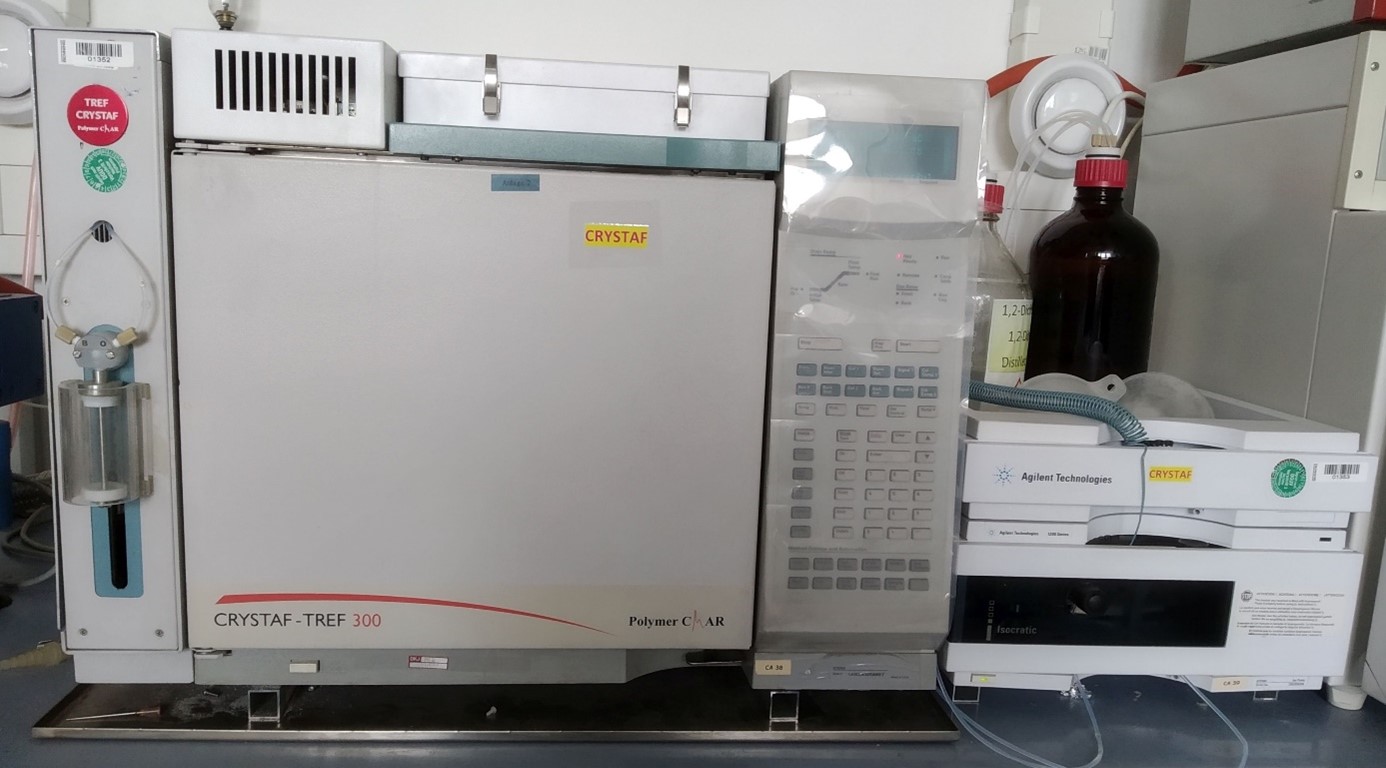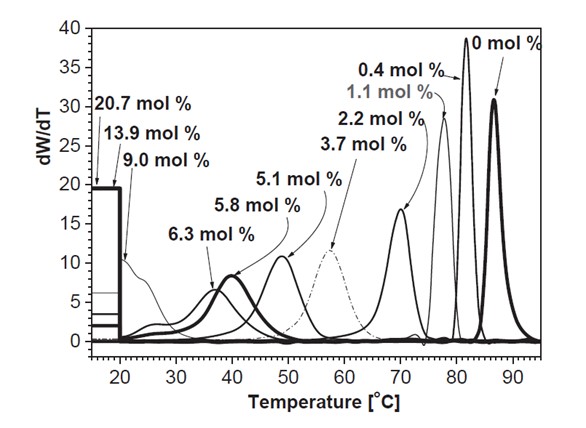Crystallization Analysis Fractionation (CRYSTAF) can be employed to characterize the composition of polyolefins. It was developed as a variation of Temperature Rising Elution Fractionation (TREF). Just like TREF, CRYSTAF is based on a (usually present) correlation between the composition and the crystallinity of a polyolefin. It was mainly developed to counter the comparatively long analysis times of TREF. By varying the analysis concept, analysis times could be significantly reduced.
Crystallization Analysis Fractionation (CRYSTAF)

Working principle
For a CRYSTAF investigation, the sample is first dissolved inside a sample cup. As is typical for polyolefins, the dissolution process necessitates high temperatures (ca. 140 – 160 °C). Subsequently, the hot polymer solution is cooled slowly. During cooling, small aliquots of the solution are taken through a filter at regular intervals. The aliquots are analyzed with an infrared (IR) detector. Thus, the composition of the solution can be monitored. The more cooling progresses, the more polymer crystallizes from the solution and the less remains dissolved. At the end of the analysis, the detector signal (or its first derivative) is plotted against the temperature. The space between data points (composition of individual aliquots) is interpolated. The first derivative of the interpolated detector signal as a function of temperature represents the composition distribution.
Comparison to Temperature Rising Elution Fractionation (TREF) and Liquid chromatography (HPLC)
Similar to TREF, CRYSTAF can be scaled well. As the analysis employs only a single crystallization step (as opposed to crystallization followed by redissolution), it can be performed significantly faster than TREF. The analysis times of HPLC (approx. 1 h) are not achieved, however, which is partially compensated by the option to analyze up to five sample in parallel with CRYSTAF. The comparability of CRYSTAF and TREF results is controversially discussed at times. Depending on the specific sample, either method can be potentially advantageous with regards to resolution.
HPLC is advantageous compared to CRYSTAF as well as TREF because of the ability to separate truly by chemical composition. CRYSTAF and TREF achieve this only indirectly based on crystallinity. This means that HPLC can be employed to characterize non-crystalline samples, which is not possible by either CRYSTAF or TREF. Furthermore, HPLC results are not influenced by crystallization effects (particularly co-crystallization) which may lead to false conclusions.
Fields of application
- Characterization of the chemical composition distribution / crystallinity distribution of polyolefins
- Comparison of material compositions
- Obtaining fractions for further, particularly spectroscopic, characterization
- Investigation of the crystallization behavior of polyolefins in solution

Publications:
- R. Chitta, T. Macko, R. Brüll, C. Boisson, E. Cossoul, O. Boyron, Characterization of the Chemical Composition Distribution of Ethylene/1-Alkene Copolymers with HPLC and CRYSTAF—Comparison of Results, Macromol. Chem. Phys. 216 (2015) 721, DOI: 10.1002/macp.201400490
- T. Macko, R. Brüll, Y. Wang, B. Coto, I. Suarez, Characterization of ethylene-propylene copolymers with high-temperature gradient adsorption liquid chromatography and CRYSTAF, J. Appl. Polym. Sci. 122 (2011) 3211, DOI: 10.1002/app.34432
- V. Dolle, A. Albrecht, R. Brüll, T. Macko, Characterisation of the Chemical Composition Distribution of LLDPE Using Interactive Liquid Chromatography, Macromol. Chem. Phys. 212 (2011) 959, DOI: 10.1002/macp.201000653
- R. Chitta, R. Brüll, T. Macko, V. Monteil, C. Boisson, E. Grau, A. Leblanc, Characterization of Ethylene methyl methacrylate and Ethylene butylacrylate Copolymers with Interactive Liquid Chromatography, Macromol. Symp. 298 (2010) 191, DOI: 10.1002/masy.201000039
- A. Albrecht, R. Brüll, T. Macko, F. Malz, H. Pasch, Comparison of High-Temperature HPLC, CRYSTAF and TREF for the Analysis of the Chemical Composition Distribution of Ethylene-Vinyl Acetate Copolymers, Macromol. Chem. Phys. 210 (2009) 1319, DOI: 10.1002/macp.200900135
- A. Albrecht, R. Brüll, T. Macko, P. Sinha, H. Pasch, Analysing the Chemical Composition Distribution of Ethylene-Acrylate Copolymers: Comparison of HT-HPLC, CRYSTAF and TREF, Macromol. Chem. Phys. 209 (2008) 1909, DOI: 10.1002/macp.200800223
- T. Macko, U. Schulze, R. Brüll, A. Albrecht, H. Pasch, T. Fónagy, L. Häussler, B. Iván, Monitoring the Chemical Heterogeneity and the Crystallization Behavior of PP-g-PS Graft Copolymers Using SEC-FTIR and CRYSTAF, Macromol. Chem. Phys. 209 (2008) 404, DOI: 10.1002/macp.200700398
 Fraunhofer Institute for Structural Durability and System Reliability LBF
Fraunhofer Institute for Structural Durability and System Reliability LBF